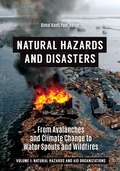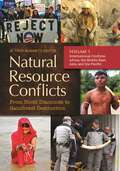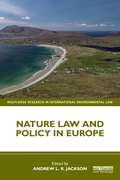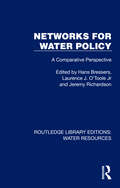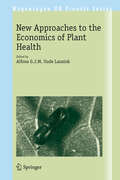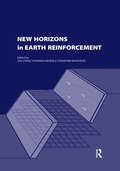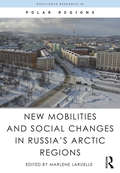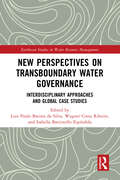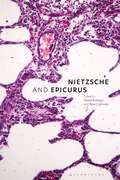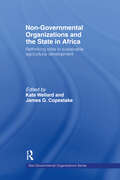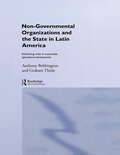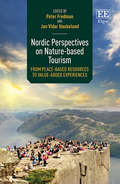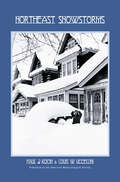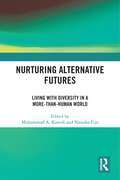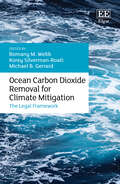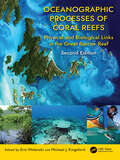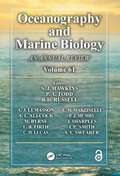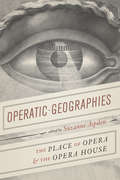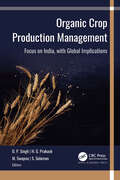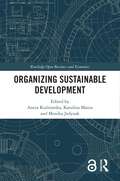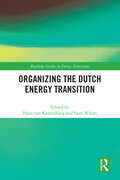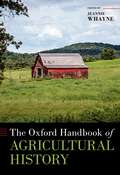- Table View
- List View
Nanoscale Characterisation of Ferroelectric Materials: Scanning Probe Microscopy Approach (NanoScience and Technology)
This book presents recent advances in the field of nanoscale characterization of ferroelectric materials using scanning probe microscopy (SPM). It addresses various imaging mechanisms of ferroelectric domains in SPM, quantitative analysis of the piezoresponse signals as well as basic physics of ferroelectrics at the nanoscale level, such as nanoscale switching, scaling effects, and transport behavior. This state-of-the-art review of theory and experiments on nanoscale polarization phenomena will be a useful reference for advanced readers as well for newcomers and graduate students interested in the SPM techniques. The non-specialists will obtain valuable information about different approaches to electrical characterization by SPM, while researchers in the ferroelectric field will be provided with details of SPM-based measurements of ferroelectrics.
Natural Hazards and Disasters [2 volumes]: From Avalanches and Climate Change to Water Spouts and Wildfires [2 volumes]
This two-volume encyclopedia provides the science behind such heart-pumping geophysical hazards as volcanic eruptions, earthquakes, cyclones, and floods, as well as authoritative entries on notable natural disasters around the world and the agencies that help those they impact.Natural Hazards and Disasters explores the sometimes harsh effects of nature on human life. The set discusses the physical science behind specific types of hazards and disasters (such as blizzards and tsunamis), their impact on our lives, how damage is mitigated or prevented, recovery and reconstruction, and the current research and technology used for managing or even eliminating the hazards.Written by experts in the field, the set also explores a variety of extreme events from around the world, including the 2010–2011 Christchurch Earthquakes (New Zealand), the 2017–2018 Thomas Fire (United States), and the 2018 Kerala Floods (India). Also covered are the world's major international and nonprofit aid agencies, like the Salvation Army and Oxfam, that assist disaster victims.
Natural Resource Conflicts [2 volumes]: From Blood Diamonds to Rainforest Destruction [2 volumes]
Natural resource and environmental conflicts have long been issues confronting human societies. This case-based examination of a wide range of natural resource disputes exposes readers to many contemporary examples that offer reasons for both hope and concern.The Rwandan genocide, the Sudanese civil war, and perpetual instability in the Middle East and Africa: each of these crises have arguably been instigated and maintained by natural resource disputes. China has undertaken a Herculean task to plant hundreds of millions of trees along its margins in an effort to save Beijing from crippling dust storms and halt the expansion of the Gobi desert. Will it work, and is it worth it? These and many other cases of conflict stemming from natural resource or environmental concerns are explained and debated in this up-to-date examination of contemporary and ongoing topics. The book examines conflicts over precious resources and minerals, such as diamonds, oil, water, and fisheries, as well as the pursuit of lesser-known minerals like Coltan and other "rare earth elements"—important resources in our technological age—in remote locations such as Greenland and the Congo. Each topic contains an overview and two position essays from different authors, thereby providing the reader with highly informative and balanced perspectives. Reference entries accompany each topic as well, helping students to better understand each issue. As the world hurtles into the 21st century, these natural resource issues are becoming increasingly important, with all global citizens having a significant stake in how these conflicts arise and play out.
Nature-Based Solutions for Cities
Nature-based solutions (NBS) are increasingly being adopted to address climate change, health, and urban sustainability, yet ensuring they are effective and inclusive remains a challenge. Addressing these challenges through chapters by leading experts in both global south and north contexts, this book advances the science of NBS in cities and discusses the frontiers for next-generation urban NBS.NBS are fundamentally inter- and transdisciplinary approaches that require systems thinking and multilevel governance. With a focus on the multiple challenges that cities face, from heat and air pollution to storm water and threats to human health, this book puts forward a diversity of ideas for embracing complexity in mainstreaming NBS and inspiring new approaches to create the ecological urban futures we need.Speaking to the need for cities around the world to employ ecological, nature-based design, this book will be essential reading for early career professionals, practitioners, scholars, and students across multiple disciplines engaging with nature-based solutions including urban ecology, design, architecture, landscape architecture, geography, urban planning, policy, and management.
Nature Law and Policy in Europe (Routledge Research in International Environmental Law)
This volume considers current and future challenges for nature law and policy in Europe. Following the Fitness Check evaluation of the Birds and Habitats Directives, in 2017 the EU adopted an Action Plan for nature, people and the economy to rapidly improve the Directives’ implementation and accelerate progress towards the EU's biodiversity targets for 2020. More recently, the EU has adopted a Biodiversity Strategy for 2030 and proposed an EU Nature Restoration Law. This book makes a timely contribution by examining the current state of play in light of recent and historical developments, as well as the post-2020 nature law and policy landscape. While evidence suggests that Natura 2000 and the Habitats and Birds Directives have delivered conservation benefits for wildlife in Europe, biodiversity loss continues apace. The book reviews the requirements for an effective international nature conservation system, with reference to the Birds and Habitats Directives. It examines regulatory regimes, current legal issues in the fields of site protection and species protection, the protection of areas outside Natura 2000, recent developments in the EU and the UK, including the implications of Brexit, agriculture and nature conservation, litigation, science and access to justice. Written by leading experts in the field, from a range of stakeholder groups, the volume draws on diverse experiences as well as providing interdisciplinary perspectives. This volume will be essential reading for students, scholars, practitioners, NGOs and policy-makers interested in European environmental policy and law, including for example lawyers, ecologists, environmental scientists, political scientists, natural resource managers, planners and civil servants.
Networks for Water Policy: A Comparative Perspective (Routledge Library Editions: Water Resources)
Network models for analysing public policy have become widely used in recent years. This volume, originally published in 1995, assesses the network idea by applying a common perspective on network analysis to the constellations involved in water policy formation and implementation in England and Wales, Germany, Hungary, the Netherlands, the USA and at the level of the EU. Water policy – addressing basic human needs for the supply of adequate surface and groundwater as well as for the maintenance and improvement of water quality, is an increasingly salient subject. Each case covered in this volume treats the issues of water policy network composition and structure, and determinants of network characteristics, as well as documenting the influence of the networks on policy developments towards more network openness, emulation of business behaviour nd less domination by traditional professional groups such as engineers. Essays by the editors provide a common analytical perspective and offer both explicitly-comparative conclusions and evidence-based assessments of the strengths and limitations of the network perspective.
New Approaches to the Economics of Plant Health (Wageningen UR Frontis Series #20)
This book presents the outcomes of a workshop around the emerging area of the economics of plant health. The workshop was organized in Wageningen in July 2005 under the auspices of Frontis – Wageningen International Nucleus for Strategic Expertise. Plant health nowadays plays an increasing role in national and international policy making. This explains the interest of the Netherlands Ministry of Agriculture, Nature and Food Quality in this workshop. The increasing importance of plant health in international policy making also follows from the recent establishment of a scientific panel on plant health by the European Food Safety Authority. This panel has to advise the EU on policy issues in the area of plant health. Plant health issues have numerous economic dimensions. Measures to control quarantine diseases and invasive species are usually costly, whereas the potential benefits, e. g. , avoided losses, are often difficult to quantify. Quantifying the costs and benefits requires close collaboration between economists and epidemiologists. New GIS tools can play an important role in visualizing and modelling the combined economic and epidemiological consequences of control measures. Quarantine organisms and invasive species also frequently have impacts that go beyond agriculture. Impacts on landscapes and the environment call for the application of new approaches to measuring the economic impacts on society. This book presents a number of new approaches to economic modelling of plant health; it is primarily intended for policy makers and scientists working in the area of plant health.
New Horizons in Earth Reinforcement: Book + CD-ROM
Earth reinforcement techniques are used worldwide, providing dependable solutions to a wide range of geotechnical engineering problems.Well-established earth reinforcement technologies are regularly augmented by new materials, innovative construction techniques and advances in design and analysis. Furthermore, reinforced earth structures are increasingly seen as expedient and economical techniques in disaster situations, such as earthquakes, flooding or tsunamis.NEW HORIZONS in EARTH REINFORCEMENT contains contributions from the 5th International Symposium on Earth Reinforcement, Kyushu, Japan, 14-16 November 2007, and presents the very latest earth reinforcement techniques and design procedures. The volume showcases advances in materials and emerging applications, with special emphasis on disaster mitigation and geoenvironmental issues. The book will be invaluable to academics and professionals ingeotechnical engineering.
New Mobilities and Social Changes in Russia's Arctic Regions (Routledge Research in Polar Regions)
This book provides the first in-depth, multidisciplinary study of re-urbanization in Russia’s Arctic regions, with a specific focus on new mobility patterns, and the resulting birth of new urban Arctic identities in which newcomers and labor migrants form a rising part of. It is an invaluable reference for all those interested in current trends in circumpolar regions, showing how the Arctic region is becoming more diverse culturally, but also more integrated into globalized trends in terms of economic development, urban sustainability and migration.
New Perspectives on Transboundary Water Governance: Interdisciplinary Approaches and Global Case Studies (Earthscan Studies in Water Resource Management)
This book presents a novel examination of transboundary water governance, drawing on global case studies and applying new theoretical approaches. Excessive consumption and degradation of natural resources can either heighten the risks of conflicts or encourage cooperation within and among countries, and this is particularly pertinent to the governance of water. This book fills a lacuna by providing an interdisciplinary examination of transboundary water governance, presenting a range of novel and emerging theoretical approaches. Acknowledging that issues vary across different regions, the book provides a global view from South and Central America, Africa, Asia, and the Middle East, with the case studies offering civil society and public managers concrete situations that indicate difficulties and successes in water sharing between bordering countries. The volume highlights the links between natural resources, political geography, international politics, and development, with chapters delving into the role of paradiplomacy, the challenges of climate change adaptation, and the interconnections between aquifers and international development. With rising demand for water in the face of climate change, this book aims to stimulate further theoretical, conceptual, and methodological debate in the field of transboundary water governance to ensure peaceful and fair access to shared water resources. This book will be of interest to students and scholars of water resource governance from a wide variety of disciplines, including geography, international relations, global development, and law. It will also be of interest to professionals and policymakers working on natural resource governance and international cooperation.
Nietzsche and Epicurus
This volume explores Nietzsche's decisive encounter with the ancient philosopher, Epicurus. The collected essays examine many previously unexplored and underappreciated convergences, and investigate how essential Epicurus was to Nietzsche's philosophical project through two interrelated overarching themes: nature and ethics. Uncovering the nature of Nietzsche's reception of, relation to, and movement beyond Epicurus, contributors provide insights into the relationship between suffering, health and philosophy in both thinkers; Nietzsche's stylistic analysis of Epicurus; the ethics of self-cultivation in Nietzsche's Epicureanism; practices of eating and thinking in Nietzsche and Epicurus; the temporality of Epicurean pleasure; the practice of the gay science, and Epicureanism and politics. The essays also provide creative comparisons with the Stoics, Hobbes, Mill, Guyau, Buddhism, and more. Nietzsche and Epicurus offers original and illuminating perspectives on Nietzsche's relation to the Hellenistic thinker, in whom Nietzsche saw the embodiment of the practice of philosophy as an art of existing.
Non-Governmental Organizations and the State in Africa: Rethinking Roles in Sustainable Agricultural Development
This presents twenty specially commissioned case studies of farmer participatory approaches to agricultural innovation initiated by NGOs in Africa. Beginning with a broad review of institutional activity at the grassroots, the authors set the case material within the context of NGO relations with the State and their contribution to democratisation and the consolidation of rural civil society. Specific questions are raised: how good/bad are NGOs at promoting technological innovation and addressing constraints to change in present agriculture?; how effective are NGOs at strengthening grassroots organizations? and how do/will donor pressures influence NGOs and their links to the State? This title is part of a series on Non-Governmental Organizations co-ordinated by the Overseas Development Institute. To complete this comprehensive review and critique there are two other regional case study volumes on Asia and Latin America and an overview volume, Reluctant Partners?
Non-Governmental Organizations and the State in Latin America: Rethinking Roles in Sustainable Agricultural Development
This presents twenty specially commissioned case studies of farmer participatory approaches to agricultural innovation initiated by NGOs in Latin America. Beginning with a broad review of institutional activity at the grassroots, the authors set the case material within the context of NGO relations with the State and their contribution to democratisation and the consolidation of rural civil society. Specific questions are raised: how good/bad are NGOs at promoting technological innovation and addressing constraints to change in present agriculture?; how effective are NGOs at strengthening grassroots organizations? and how do/will donor pressures influence NGOs and their links to the State? This title is part of a series on Non-Governmental Organizations co-ordinated by the Overseas Development Institute. To complete this comprehensive review and critique there are two other regional case study volumes on Asia and Africa and an overview volume, Reluctant Partners?
Nordic Perspectives on Nature-based Tourism: From Place-based Resources to Value-added Experiences
Nature-based tourism (NBT) is a sector where entrepreneurial success is highly knowledge driven. This insightful book offers a comprehensive evaluation of NBT in a Nordic context, highlighting how long-established Nordic traditions of outdoor recreation practices can reveal lessons for the field more broadly. Featuring contributions from expert scholars, Nordic Perspectives on Nature-Based Tourism examines the links between place-based resources and value-added experiences. It considers the way in which NBT calls for an integrated approach to manage resources for both outdoor recreation and the development of commercial experience products. Chapters explore Nordic and international perspectives, local communities, market dynamics, firms, creativity, innovations and value-added experience products. Undergraduate and graduate students and scholars in tourism and related fields such as geography, planning, hospitality, outdoor recreation and natural resource management will find the knowledge and understanding gained from the book invaluable. It will also prove useful for policymakers, entrepreneurs and volunteers.
Northeast Snowstorms: Volume 1 and Volume 2 (Meteorological Monographs #32, No. 54)
Designed with researchers, students, and weather observers and enthusiasts in mind, Northeast Snowstorms takes the unique approach of utilizing conventional weather charts and detailed descriptions of individual storms to analyze storms in a multi-disciplinary way. The most comprehensive treatment of winter storms ever compiled, this two-volume set includes case studies, insights, historic photos, and 200 color figures. The extra material on the SpringerExtras server contains five days of complete reanalysis data at 35-km grid resolution and 64 vertical levels for each of the cases. This allows everyone from enthusiasts to students to conduct their own diagnostic studies or research projects for any of the 70 historic cases, from a PC or workstation environment. Instructors take note: this is an excellent tool for creating classroom exercises.
Nurturing Alternative Futures: Living with Diversity in a More-than-Human World
Developing upon emerging environmental humanities and multispecies anthropological theories, this book provides a fresh perspective on how we might rethink more-than-human relationality and why it is important to "nurture alternative futures." The diverse chapters examine the life trajectories of people, animals, plants, and microbes, their lived experiences and constituted relationality, offering new ways to reinterpret and reimagine a multi-species future in the current era of planetary crisis. The ethnographic case studies from around the world feature a combination of biological and cultural diversity with analyses that prioritize local and Indigenous modes of thinking. While engaging with Mongolian herders, Indigenous Yucatec Mayan, Congolese farmers, rural Pakistani donkey keepers, Australian heritage breed farmers, Croatian cheesemakers, Japanese oyster aquafarmers, Texan corn growers, Californian cannabis producers, or Hindu devotees to the Ganges River, the chapters offer a grounded anthropological understanding of imagining a future in relationality with other beings. The stories, lived experiences, and mutual worlding that this volume presents offer a portrayal of alternative forms of multispecies coexistence, rather than an anthropocentric future.
Occupant-Centric Simulation-Aided Building Design: Theory, Application, and Case Studies
Occupant-Centric Simulation-Aided Building Design promotes occupants as a focal point for the design process. This resource for established and emerging building designers and researchers provides theoretical and practical means to restore occupants and their needs to the heart of the design process. Helmed by leaders of the International Energy Agency Annex 79, this edited volume features contributions from a multi-disciplinary, globally recognized team of scholars and practitioners. Chapters on the indoor environment and human factors introduce the principles of occupant-centric design while chapters on selecting and applying models provide a thorough grounding in simulation-aided building design practice. A final chapter assembling detailed case studies puts the lessons of the preceding chapters into real-world context. In fulfillment of the International Energy Agency’s mission of disseminating research on secure and sustainable energy to all, Occupant-Centric Simulation-Aided Building Design is available as an Open Access Gold title. With a balance of fundamentals and design process guidelines, Occupant-Centric Simulation-Aided Building Design reorients the building design community toward buildings that recognize and serve diverse occupant needs, while aiming for superior environmental performance, based on the latest science and methods.
Ocean Carbon Dioxide Removal for Climate Mitigation: The Legal Framework
Examining the existing legal framework for ocean carbon dioxide removal (CDR), this forward-thinking book highlights potential legal challenges and opportunities associated with using the ocean to remove and store carbon dioxide from the atmosphere. It describes five commonly discussed ocean CDR techniques, including rock-based ocean alkalinity enhancement (OAE), electrochemical OAE, ocean fertilization, artificial upwelling and downwelling, and seaweed cultivation, and explores the legal issues that different techniques could raise.This timely book explores the laws governing ocean CDR research and deployment at the international level and domestically in seven countries across Asia, Europe, and North America. The analysis highlights the complexities and uncertainties associated with applying existing international and domestic law to ocean CDR, providing lawyers and policymakers with invaluable insights into areas where legal reforms are needed to facilitate in-ocean research and deployment.This book is essential reading for lawyers, policymakers, and others interested in advancing innovative climate change solutions. It will also appeal to academic and private sector scientists who are conducting research into ocean CDR.
Oceanographic Processes of Coral Reefs: Physical and Biological Links in the Great Barrier Reef
In the last two decades since publication of the first edition, substantial advancements have been made in the science, the need for transdisciplinary approaches to coral reef protection greater than ever before. This new edition, now in full color throughout with accompanying animations, goes beyond identifying foundational information and current problems to pinpoint science-based solutions for managers, stakeholders and policy makers. Coral reefs are connected by currents that carry plankton and the larvae of many reef-based organisms. Further, they supply food to reefs. Currents also bring pollutants from the land and, together with the atmosphere, affect the surrounding ocean. The chapters in this book provide a much-needed review of the biophysics of reefs with an emphasis on the Great Barrier Reef as an ecosystem. The focus is on interactions between currents, waves, sediment and the dynamics of coastal and reef-based ecosystems. The topographic complexity of reefs redirects mainstream currents, creates tidal eddies, mushroom jets, boundary layers, stagnation zones, and this turbulence is enhanced by the oceanographic chaos in the adjoining Coral Sea. This is the environment in which particles and organisms, of a range of sizes live, from tiny plankton to megafauna. This generates faunal connectivity at scales of meters to thousands of km within the Great Barrier Reef and with the adjoining ocean. Pollution from land-use is increasing and remedial measures are described both on land and on coral cays. The impact of climate change is quantified in case studies about mangroves and corals. Modelling this biophysical complexity is increasing in sophistication, and the authors suggest how the field can advance further.
Oceanography and Marine Biology: An annual review. Volume 61 (Oceanography and Marine Biology - An Annual Review #61)
Oceanography and Marine Biology: An Annual Review remains one of the most cited sources in marine science. The increasing interest in work in oceanography and marine biology and its relevance to global environmental issues, especially global climate change and its impacts, creates a demand for authoritative refereed reviews summarising and synthesising the results of both historical and recent research. For more than 50 years, OMBAR has been an essential reference for researchers, students and workers in all fields of marine science. An international Editorial Board ensures global relevance and expert peer review, with editors from Australia, Hong Kong, Ireland, Singapore, and the UK. The series of volumes can be found in the libraries of institutes and universities worldwide. Five of the seven peer-reviewed contributions in Volume 61 are available to read Open Access via this webpage and on OAPEN. Supplementary material is provided online on the Support Materials tab on the book’s www.routledge.com webpage for Reviews 1, 2, 4, 5 and 6.. Volume 61 features a review of 100 years of daily sea surface temperature from the Hopkins Marine Station in Pacific Grove, California; an exploration of the biology and life cycle of enigmatic crustacean y-larvae; a review of the science, policy and management of the Central and South Atlantic Deep Sea benthos; a review of the biodiversity of the Irish-Scottish continental margin; an investigation of how new molecular tools can be used for marine biodiversity and ecosystem assessments, and a look at the resilience of marine organisms to climate change. A final monograph considers enemy shells as refugia from grazing and competition pressure. If you are interested in submitting a review for consideration for publication in OMBAR, please email the new co-Editors in Chief, Dr Peter Todd (dbspat@nus.edu.sg) and Dr Bayden Russell (brussell@hku.hk). Guidelines for contributors to OMBAR, including information on illustration requirements, can be downloaded on the "Support Material" tab on the latest volume’s webpage.
Operatic Geographies: The Place of Opera and the Opera House
Since its origin, opera has been identified with the performance and negotiation of power. Once theaters specifically for opera were established, that connection was expressed in the design and situation of the buildings themselves, as much as through the content of operatic works. Yet the importance of the opera house’s physical situation, and the ways in which opera and the opera house have shaped each other, have seldom been treated as topics worthy of examination. Operatic Geographies invites us to reconsider the opera house’s spatial production. Looking at opera through the lens of cultural geography, this anthology rethinks the opera house’s landscape, not as a static backdrop, but as an expression of territoriality. The essays in this anthology consider moments across the history of the genre, and across a range of geographical contexts—from the urban to the suburban to the rural, and from the “Old” world to the “New.” One of the book’s most novel approaches is to consider interactions between opera and its environments—that is, both in the domain of the traditional opera house and in less visible, more peripheral spaces, from girls’ schools in late seventeenth-century England, to the temporary arrangements of touring operatic troupes in nineteenth-century Calcutta, to rural, open-air theaters in early twentieth-century France. The essays throughout Operatic Geographies powerfully illustrate how opera’s spatial production informs the historical development of its social, cultural, and political functions.
Organic Crop Production Management: Focus on India, with Global Implications
Covering a wide array of topics on the status and challenges of organic farming, including production, nutrient management, plant protection, processing methods, organic production, policy issues, etc., in food crops, vegetable crops, and sugarcane, this new volume addresses how organic farming is an attractive option toward the reduction of toxic emissions produced from traditional agriculture and how it can help mitigate the deleterious effects on crops from climate change. With a focus primarily on India but with application elsewhere in the agricultural world, the volume looks at organic crop production in conjunction with ensuring rural livelihood security, maintaining and enhancing soil health, sugarcane productivity and sugar industry by-products, nutritional management in system-based organic farming, the management of pests in organic farming, the use of vermiculture as an important method for organic farming, and much more. The volume also looks at the issues and challenges in the marketing of organic produce.
Organizing Sustainable Development (Routledge Open Business and Economics)
The role and meaning of sustainable development have been recognized in the scientific literature for decades. However, there has recently been a dynamic increase in interest in the subject, which results in numerous, in-depth scientific research and publications with an interdisciplinary dimension. This edited volume is a compendium of theoretical knowledge on sustainable development. The context analysed in the publication includes a multi-level and multi-aspect analysis starting from the historical and legal conditions, through elements of the macro level and the micro level, inside the organization. Organizing Sustainable Development offers a systematic and comprehensive theoretical analysis of sustainable development supplemented with practical examples, which will allow obtaining comprehensive knowledge about the meaning and its multi-context application in practice. It shows the latest state of knowledge on the topic and will be of interest to students at an advanced level, academics and reflective practitioners in the fields of sustainable development, management studies, organizational studies and corporate social responsibility.
Organizing the Dutch Energy Transition (Routledge Studies in Energy Transitions)
This book addresses learnings from the energy transition in the Netherlands.This book brings together contributions from experts in academia and practice to the Dutch energy transition by sharing their knowledge and experience gained over many years and from different roles and responsibilities. The chapters are clustered around four key perspectives – Policy, Sector, Organization, and Future – and explore the impact of policy decisions of governments and strategic decisions of firms operating in the energy sector on the energy transition process. The different perspectives present many promising strategies, policies, and innovations on each aspect, resulting in a deeper understanding of how each of these strategies, policies, and innovations may hinder or contribute to foster the energy transition. It concludes with a reflection on lessons learned and specific managerial and policy recommendations.This volume will be of great interest to students, scholars, and industry professionals researching and working in the areas of energy transitions, sustainable business, energy technology, and energy policy.
The Oxford Handbook of Agricultural History (Oxford Handbooks)
Agricultural history has enjoyed a rebirth in recent years, in part because the agricultural enterprise promotes economic and cultural connections in an era that has become ever more globally focused, but also because of agriculture's potential to lead to conflicts over precious resources. History is replete with stories of armies standing or falling as a result of their supply of agriculturally produced commodities. Civilizations have likewise succumbed because of famine or crop-related pestilence, highlighting the critical nature of agriculture to both regional and global society. The importance and fragility of agricultural systems will come into much greater focus because of climate change in the twenty-first century, something farmers the world over have begun to reckon with. As its implications are manifested in droughts and floods that hamper crop production, urban people will become ever more conscious of their own reliance upon agriculture. The contemporary critical evaluation of agriculture reflects a transition from a framework that celebrated the positive aspects of the evolution of agriculture to one that also explores its negative implications, such as the emergence of intensive and extractive agriculture that has worked to the detriment of indigenous peoples and disrupted traditional political economies. The Oxford Handbook of Agricultural History reflects this rebirth and examines the wide-reaching implications of agricultural issues, bringing together the many historiographical traditions within geographic regions across the world that intersect either directly or indirectly in terms of agricultural history. Contributors to this volume include historians from around the world and specialists in European, American, African, Middle East, Russian, and Asian history. Essays touch on the green revolution, the development of the Atlantic slave plantation, the agricultural impact of the American Civil War, the rise of scientific and corporate agriculture, and modern exploitation of agricultural labor. The Oxford Handbook of Agricultural History is an essential volume for those interested in the myriad ways that agricultural systems affect our world.

